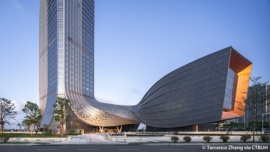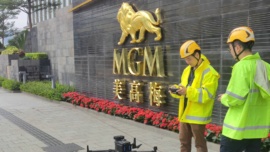The Greater Bay Area has great potential to be a central metropolis region for the One Belt, One Road (OBOR) policy, but better integration of financial and judicial systems of its different cities and regions would be necessary, several economics and external policy experts stated yesterday at the International Conference on Belt and Road and Macao’s Development.
“The extraordinary connectivity in the Pearl River Delta by road, rail and waterways is setting the scene for a globally emerging cluster of cities, including Macau. [The Greater Bay Area] has the potential to become an economic and intellectual powerhouse unmatched anywhere in the world. […] There could be a ‘one megapolis, two systems’ policy,” enthused Richard Vuylsteke, President of the East-West Centre.
The importance of the Greater Bay Area was also echoed by the former Minister of Foreign Affairs of Thailand, Surakiart Sathiratha, who believes the area could be a mainstay for OBOR.
“The 11 cities in the area account for US$1.5 trillion (MOP12.04 trillion) in trade and with the combined economic size of the area being equivalent to the world’s tenth largest economy, the Greater Bay Area promises to be one of the pillars of OBOR,” Mr. Sathiratha stated yesterday.
According to Sathiratha, currently Chairman of the Asian Peace and Reconciliation Council, the Bay Area provides a “strong counterpart” for the ASEAN Economic Community and the Lancing-Mekong co-operation initiatives, facilitating improved Asian co-operation.
Getting the VIP ticket
For the Macau Economic Association Chairman, Lao Chi Ngai, the Greater Bay Area has the “VIP ticket” to take part in the OBOR development’s “high speed train” – although there are different views on how to get that ticket.
According to Mr. Ngai, the Chinese central government should create more policies for co-operation between Guangdong Province, Macau and Hong Kong while protecting each region’s special advantages.
“A Close Economic Arrangement (CEPA) was created for Hong Kong and Macau for cross-border trade with Mainland China but we still need to improve co-operation in other areas,” he added.
For Mr. Lao, that increased co-operation could involve creating “one-stop customer control, single licences to allow entry to the three regions, a seamless Guangdong-Macau transport system,” and turning the MSAR into a tariff-free outpost for Portuguese-speaking countries’ products.
According to Zheng Yongnian, the Director of East Asian Studies at the National University of Singapore, the Chinese government is seeking to encourage private companies to invest abroad by mobilising state-owned companies, but the reach of companies from the interior of China is limited.
“That’s why Guangdong, Hong Kong and Macau can position themselves as an important part of OBOR as an international platform,” he added.
Zheng believes that in order to assume a leading role in OBOR, there should be better integration and co-operation between cities like Macau, Shenzhen and Zhuhai, following a model similar to that of the European Union.
“We could take lessons from the European Union; we could create a common real estate market, a common financial market, and a common financial sector. Integration is very important and it would be easier to achieve in the Greater Bay Area since the different cities are not sovereign countries as in the European Union,” he stated.
Growing pains
However, the MSAR Legislator and Director of the Macau Development Strategy Research Centre, Sio Chi Wai, warned that integration would require “proper policy design” to resolve any of the problems that could arise from the difference between legal systems enforced in the different regions.
For the former President of the Hong Kong Institute of Planners, Ling Kar Kan, such a large and integrated Greater Bay Area metropolis would have to be a “liveable city” with a development plan focused on sustainable solutions.
“[Guangdong-Macau-Hong Kong] should make a comprehensive plan for living conditions. There needs to be a good ecological environment, development of recreational facilities, the setting up of public services that put people first, and creation of an interconnected and efficient transport system,” he concluded.
























